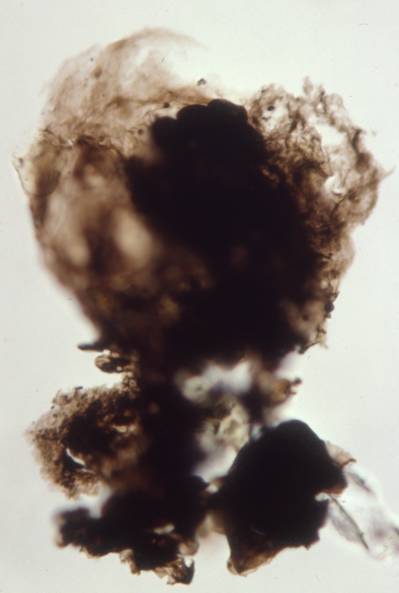

46740-B8
A Study of the Algal-Plant Transition Based on Organic Remains from Cambrian Strata
The project is concerned with the collection and recovery of organic fragments, including spores, from Cambrian shales, principally from the Middle to Upper Cambrian of the Conasauga Group in eastern Tennessee. These remains have the potential to produce, for the first time, a tangible fossil record of evolution of plants during the transition from algae (which are fundamentally an aquatic group) to the land plants (belonging to terrestrial, or subaerial, ecosystems). In December, 2007, the project got underway with the sampling of sections of three cores housed at the Oak Ridge National Laboratories in Oak Ridge Tennessee. Samples from the Nolichucky Shale from ORNL cores GW-130 and JOY-2 have yielded wefts of organic filamentous tissues with oblique cross walls. This particular morphologic feature is unique to botany where it is found only the protonema and rhizoids of true mosses (Musci) and in rhizoids of liverworts (Hepaticae). This material will become the basis for comparative study with extant protonema/rhizoids beginning in the fall of 2008 in new collaborations with researchers studying spores and protonema in modern bryophyte groups. Equally exciting has been the discovery in ORNL core GW-130 of what appear to be small sporangia, some of which contain spores. These include the globose form (pictured in Figure 1) in addition to more linear, sac-like structures. In collaboration with a colleague from Sheffield University/Natural History Museum (London), we have sampled the Middle to Upper Cambrian transition at Thorn Hill (a classic section for the Conasauga Group in eastern Tennessee) in early September 2008. These samples will be processed during the fall of 2008 and we expect to have additional material to examine beginning in early 2009.
These are very exciting times for the study of the fossil record of the origin of land plants. The materials under examination during this project are from sediments which are considerably older that the currently accepted ages for land plant origins. However, as work on both spores and small fragments continues forward, we are beginning to see a convergence of separate lines of evidence indicating a much earlier origin to the land plants than previously thought. Recent collaborations with Wilson A. Taylor (see publications) have begun to shed light on the possible origins of the primitive spore wall in land plants, and have now provided us with concrete examples of how extant spores may have evolved from algal ancestors as they shifted dispersal functions from the diploid phase to the haploid generation. We also have discovered spore wall ultrastructure in cryptospore dyads of Middle Cambrian age that appear very close in structure to spores of Riccia, a living liverwort. This work provides the basis for a new look at character evolution amongst the bryophytes and may provide a more rigorous method of establishing a minimal age for the origin of embryophytes (land plants) as Middle Cambrian.
Figure 1. Globose sac-like structure with an enclosed spore
cluster. This structure appears to represent a possible sporangium, which, if
further study supports this interpretation, would be the earliest known example
of a multicellular spore-bearing land plant. The structure is small, less than
300 microns wide, and is found in the Nolichucky Shale in eastern Tennessee.
Its age is Late Cambrian.
